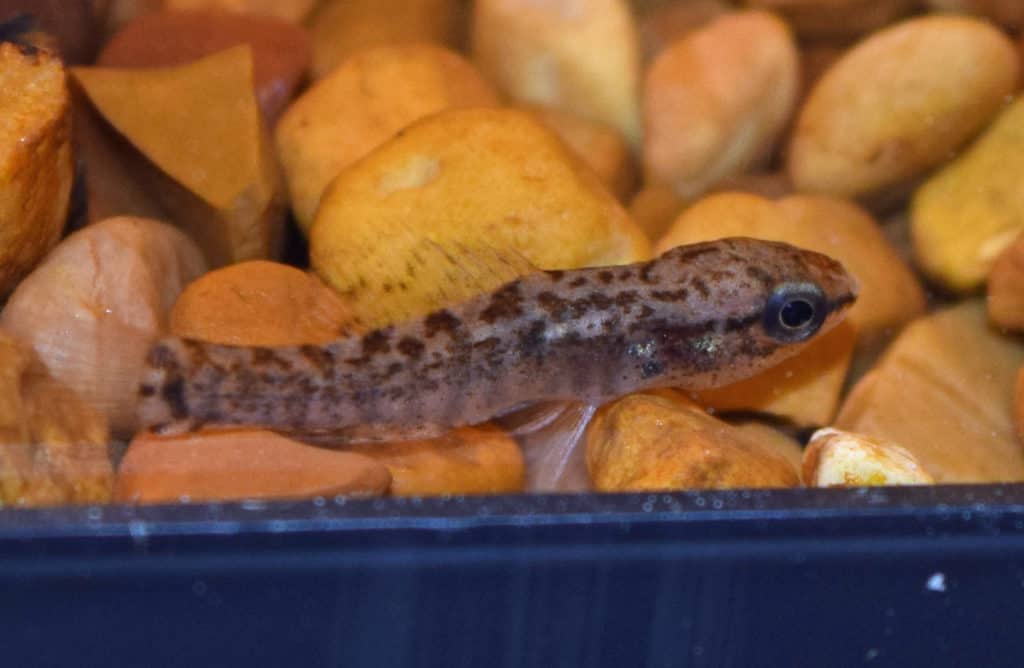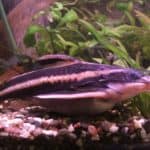The Banded Pygmy Sunfish (Elassoma zonatum) is a curious fish, mainly because of its small size. This species of fish is distributed over a part of the United States.
They have a unique appearance, with brown colors typical of wild fish dotted with beautiful bright, bright spots.

Species Summary
Distributed over a wide area in the USA, the Banded Pygmy Sunfish is a subtropical freshwater fish belonging to the Elasomatidae family. The species occurs in places with a muddy substrate, such as swamps, densely vegetated sloughs, and small streams of slow water.
Geographically they are distributed in the Lower Roanoke River drainage in North Carolina; south to middle parts of St. Johns River, Florida; west to Brazos River drainages, Texas; and north to lower Wabash River drainage, Indiana and Illinois, USA.
These are small-sized fish and are the perfect species for an aquarium because of their rusticity and low maintenance requirements; they can even live in aquariums without a heater.
Its main feature that makes an extraordinary impact on those who observe it is its unique appearance – bright spots.
It is a relatively rare species in aquariums around the world but has been popular in the hobby for years by those who live close to its area of occurrence. It is a great species of fish for any hobbyist.
Generally speaking, the Pygmy Sunfish is a hardy and peaceful fish in aquariums, making it an excellent choice for aquarists looking for something different, rustic, and rare in their tank.
Banded Pygmy Care Guide
Even though the species has been kept in aquariums for decades by collectors who live in the region where these fish occur, it is a relatively scarce species in the aquarium hobby, with very few breeders in Europe.
The Banded Pygmy Sunfish is a solitary species, but it can live in groups, forming a colony.
The Banded Pygmy Sunfish is a stunning fish when well taken care of; even if they’re not seen in the aquarium very often, they will show their best colors and be seen more often when they receive a balanced diet and are in a proper aquarium.
Despite being sensitive to sudden changes and, in a way, the quality of the water, it is a resistant fish and is easy to care for. But it’s important to know the species, its habits, and behaviors. Like any other species, the Banded Pygmy Sunfish has its peculiarities, addressed and detailed in the following topics.
Tank Size
Banded Pygmy Sunfish are small, shy fish who spend most of their time hiding. Because of this, they do not require a large aquarium.
An aquarium of around 10 gallons is enough to keep a couple. Remember that, like most fish, the more space available, the better for the fish’s well-being.
Tankmates
They are peaceful and non-territorialists who coexist with other fish in a community aquarium. However, it is better to keep a group of the same species alone.
If you choose to keep it in a community tank, preferably combine with fish of the same size and behavior. Avoid keeping it with large, territorial, and aggressive fish.
The species is not tolerant of its relatives, with aggression and territorialism occurring, although fights that end in injury are rare.
Same Species Tanks
Given its behavior and relative fragility due to its size, keeping a group of this species in the aquarium is recommended. Aggressions occur even in well-formed groups.
Try to maintain the sex ratio of one male to two females.
They are often used as a single species in biotope-type aquarium setups, where the original location of occurrence of the species is imitated.
Water Parameters
They are resistant fish after adaptation, but they do not support sudden parameter changes or a wide range of parameters. This species is resistant to some types of pollutants in the water.
This pygmy sunfish can live with excellent quality in different and restricted parameters; the perfect temperature for its maintenance is from 60 to 80F. The ideal pH range is between 6.5 to 7.0 and hardness from 8 to 12°H. This species does well in more acidic waters (high hardness).
What to Put in Their Tank
Different from other aquatic animals, an aquarium heater and a filtering system is not essential to keep the tank with Banded Pygmy Sunfish healthy. If you do use a filtration system, it must be well dimensioned. Create a low to moderate flow as this species inhabits still waters or low flow.
The aquarium’s decoration will be critical in the maintenance of the species, which needs many hiding places and caves. Densely planted aquariums are an excellent choice for keeping this animal, which hides under leaf litter at the bottom of the ponds in the wild.
It is also beneficial to keep lots of driftwood and rocks forming hiding places, caves of different sizes, and territories. Lighting should be dim, and floating plants are excellent inclusions.
Common Diseases
They are remarkably disease-resistant fish. Keeping the quality of the water and the tank always in optimal conditions and a good quality diet, your fish should not present any problem.
Remember to always quarantine new fish before placing them in the main aquarium.
Food and Diet
Like other pygmy sunfish, this species is carnivorous and nocturnal, feeding on benthic invertebrates, fish, detritus, and plant material.
In its natural environment, its primary diet is based on micro-crustaceans together with midge larvae, larger crustacea (isopods and amphipods), mayfly nymphs, and tiny snails and clams.
In aquariums, this fish may have problems accepting commercial rations. Live and fresh food like live fish, brine shrimp, bloodworms, earthworms, and others should be offered regularly to Banded Pygmy Sunfish.
Providing a varied and balanced diet is essential for demonstrating its full potential.
Lifespan
In an aquarium with all the correct parameters kept stable and with an ideal diet, the Banded Pygmy Sunfish can live around two years.
In nature, these animals are prone to live less, as they are predisposed to diseases, attacks from other animals, and environmental causes.
Appearance
Banded Pygmy Sunfish is a small fish where the breeding males are colored. In general, the breeding male is dark in color, with dark vertical stripes perpendicular to the body, some dark spots, and iridescent spots along the body, especially on the cheek.
Females are softer in color compared to males.
Size
The Banded Pygmy Sunfish is the largest species of pygmy sunfish and can quickly grow to nearly two inches in length when well cared for and fed.
However, the most common in domestic aquariums is to find animals around 1.3 inches in length.
Behavior and Temperament
Banded Pygmy Sunfish is a species of subtropical fish of peaceful behavior and extremely shy, being kept in a community aquarium with smaller fish or of the same size; preferably, they should be kept with those of the same species.
Males can display aggression and territoriality with other males of the same species, but aggression rarely leads to death.
Breeding
Captive breeding is scarce; however, it is carried out commercially in Europe and by a few North American hobbyist aquarists. Unfortunately, it is not a widespread species in the hobby, like other North American fish.
It is an oviparous species, where the female releases eggs freely in the middle (egg-scattering species). Like other pool fish, the female lays her eggs in places close to the substrate or under leaf litter; the male then fertilizes these eggs.
With males guarding the eggs, parental care occurs, but fingerling cannibalism can occur.
The fry is tiny, needing to be fed with infusoria.
Gender Differences: Male vs. Female
There is apparent sexual dimorphism. Males are notably more colorful than females.
Banded Pygmy Sunfish Fun Facts
- This species was first introduced to European hobbyists around 2015.
- Among all the pygmy sunfish species, this one is the largest.
- Pygmy sunfish are little appreciated and known among aquarists, but they are within a specific niche and are gaining in popularity like other nano fish.
- Members of the Elasomatidae family are collectively known as pygmy sunfish but are not considered true sunfish, which are contained within the family Centrarchidae.
- The Banded Pygmy Sunfish maintains the same characteristics as juveniles as an adult.
- When discovered, the Banded Pygmy Sunfish belonged to the cichlid family.
- The scientific name of the Banded Pygmy Sunfish is Elassoma zonatum, where Elassoma means small body and Zonatum means banded.
References
Barney, R.L. and B.J. Anson. 1920. Life history and ecology of the pygmy sunfish Elassoma zonatum. Ecology 1(4):241-256.
Böhlke, J.E. and Rhode F.C. 1980. Elassoma zonatum (Jordan), Banded pygmy sunfish. pp. 586 in D.S. Lee et al. Atlas of North American Freshwater Fishes. N.C. State Mus. Nat. Hist., Raleigh, i-r+854 pp.
Branson, B.A. 1974. Pygmy sunfish for community aquaria. Tropical Fish Hobbyist 22(10):17-22.
Coker, A.F., Jr. 1917. The pygmy sunfishes. Aquatic Life 3(2):22-24.
Cook, F.A. 1959. Freshwater fishes in Mississippi. Mississippi Game and Fish Commision, Jackson.
Page, L.M. and B.M. Burr, 1991. A field guide to freshwater fishes of North America north of Mexico. Houghton Mifflin Company, Boston. 432 p.








